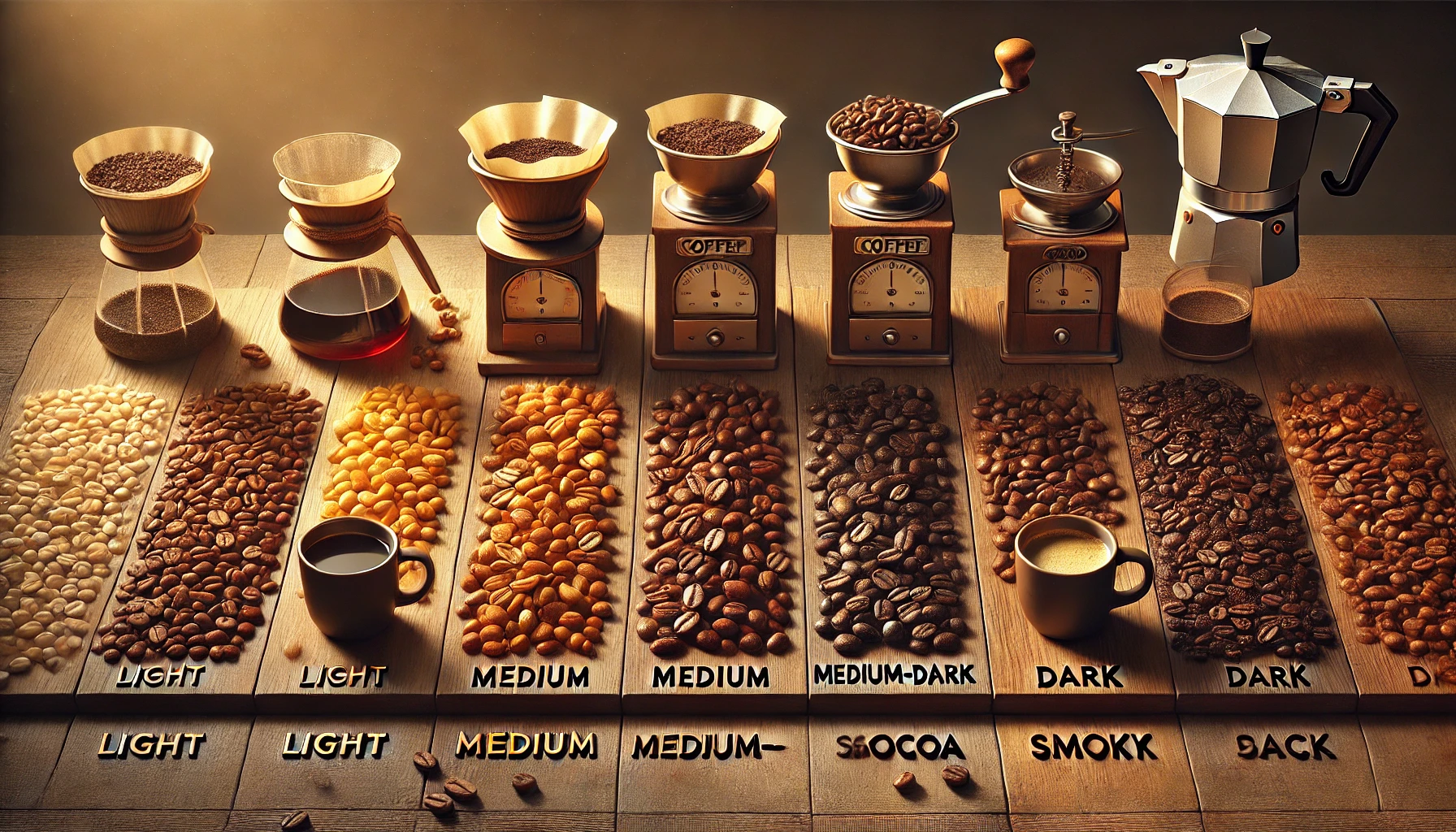Coffee roasting is more than just turning green beans brown—it’s a precise craft that transforms raw coffee into a rich, aromatic, and flavorful experience. From light and citrusy to dark and smoky, the roast level can completely change the taste of your coffee.
In this article, you’ll learn how roasting affects flavor, aroma, acidity, and body—and how to choose the right roast level for your personal taste.
What Happens During Roasting?
Roasting involves heating green coffee beans to temperatures ranging from 180°C to 240°C (356°F to 464°F). During this process, the beans:
- Lose moisture and expand
- Go through the Maillard reaction (browning of sugars and amino acids)
- Undergo caramelization, enhancing sweetness and aroma
- Develop oil on the surface (in darker roasts)
Each stage of roasting triggers chemical changes that impact the flavor compounds inside the bean.
The Four Main Roast Levels
1. Light Roast
- Temperature: Ends at ~196°C (385°F), right after “first crack”
- Color: Light brown, no oil on surface
- Flavor profile:
- Bright acidity
- Floral, fruity, and tea-like notes
- Preserves origin characteristics
- Body: Light
- Best brew methods: Pour-over, Chemex, AeroPress
Light roasts highlight the bean’s origin, perfect for exploring terroir and subtle flavors.
2. Medium Roast
- Temperature: Ends at ~210°C (410°F), after first crack, before second
- Color: Medium brown, dry or slightly shiny
- Flavor profile:
- Balanced acidity and sweetness
- Notes of caramel, chocolate, nuts
- Slight roastiness, retains origin clarity
- Body: Medium
- Best brew methods: Drip coffee, French press, espresso
Medium roast is often the most approachable and versatile—great for both beginners and connoisseurs.
3. Medium-Dark Roast
- Temperature: Ends at ~219°C (426°F), near “second crack”
- Color: Rich brown with light oil
- Flavor profile:
- Lower acidity
- Bolder flavors: dark chocolate, spice, roasted nuts
- Some origin flavors still detectable
- Body: Full
- Best brew methods: Espresso, moka pot, cold brew
Great for people who enjoy a bold, less acidic cup with strong aroma.
4. Dark Roast
- Temperature: Ends at 225°C–240°C (437°F–464°F)
- Color: Dark brown to black, oily surface
- Flavor profile:
- Smoky, bitter-sweet, toasty
- Notes of charcoal, cocoa, burnt sugar
- Origin flavors mostly masked by roast
- Body: Heavy
- Best brew methods: Espresso, French press
Popular in Italian and French-style coffees, dark roasts offer a robust, intense experience.
Flavor Transformation by Roast Level
| Roast Level | Acidity | Sweetness | Bitterness | Flavor Notes |
|---|---|---|---|---|
| Light | High | Medium | Low | Citrus, floral, berry, tea-like |
| Medium | Medium | High | Low-Med | Caramel, milk chocolate, almond |
| Medium-Dark | Low-Med | Medium | Medium | Cocoa, spice, toasted nuts |
| Dark | Low | Low | High | Smoke, burnt sugar, dark chocolate |
As you go darker, acidity and sweetness decrease, while bitterness and body increase.
How to Choose the Right Roast for You
| Preference | Ideal Roast Level |
|---|---|
| Bright, fruity, origin-focused | Light |
| Balanced and sweet | Medium |
| Bold with less acidity | Medium-Dark |
| Intense, rich, and bitter-sweet | Dark |
Try different roasts of the same origin to see how flavor changes with the roast profile.
Roasting and Brewing Compatibility
Some roast levels work better with certain brewing methods:
- Light roasts: Best for pour-over and slow extractions
- Medium roasts: Great all-rounders
- Dark roasts: Ideal for espresso and milk-based drinks
- Cold brew: Medium-dark roasts yield a rich, smooth flavor
Matching roast with your brew method helps you get the most out of your beans.
Can You Roast at Home?
Yes! Home roasting lets you explore the full roasting spectrum:
- Tools: popcorn popper, dedicated roaster, oven, cast iron pan
- Watch for color, aroma, and first/second crack
- Start with small batches
- Always cool beans quickly and let them rest for 24–48 hours before brewing
It’s a fun way to deepen your connection to coffee—but be prepared to experiment!
Final Thoughts: Roast Is the Recipe
Roasting is where green beans become the coffee you love—it’s the bridge between the farm and your cup. Whether you prefer bright and complex or bold and smoky, the roast level is your flavor foundation.
Understanding how roasting shapes flavor helps you choose better beans, explore new profiles, and enjoy a cup that truly suits your taste.
So next time you shop for coffee, don’t just grab what looks familiar—try a different roast and taste the transformation.
